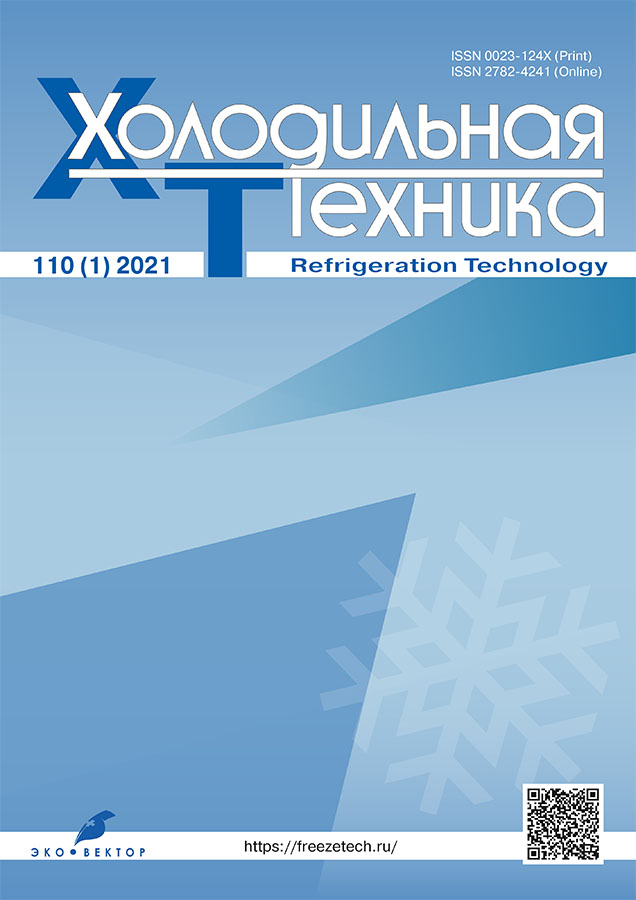Ways to use refrigerators that use heat to cool vehicles
- Authors: Kolesnikov A.S.1, Krotov A.S.1, Kosenko G.M.1, Mazyakin M.S.1
-
Affiliations:
- Bauman Moscow State Technical University (national research university)
- Issue: Vol 110, No 1 (2021)
- Pages: 41-49
- Section: Original Study Articles
- URL: https://freezetech.ru/0023-124X/article/view/490860
- DOI: https://doi.org/10.17816/RF490860
- ID: 490860
Cite item
Abstract
BACKGROUND: Today, most of the heat released during the combustion of fuel in internal combustion engines goes into the environment along with exhaust gases. However, this can be used as additional energy for refrigeration and air conditioning. Previously, there were only two ways to use exhaust heat for cooling: absorption machines and ejector chillers. However, thanks to the development of organic Rankine cycles, there are new possibilities for cooling vehicles.
AIMS: This study aims to theoretically analyze the possibility of introducing mobile air conditioning and refrigeration systems in transport using various types of refrigeration machines that operate on the basis of heat.
MATERIALS AND METHODS: Typical cooling cycles were modeled in the ASPEN HYSYS software environment. The most effective substances were selected from the absence of supercritical conditions.
RESULTS: Depending on the selected cycle type, simulation results were obtained that corresponded to the calculated parameters. The coefficients of performance were determined under various ambient conditions and generator temperatures.
CONCLUSIONS: Various cooling cycles for use in transport were theoretically analyzed. The results of the calculations show that the cooling of the cabin or cargo was ensured even in harsh operating conditions of the refrigeration system.
Keywords
Full Text
About the authors
Andrey S. Kolesnikov
Bauman Moscow State Technical University (national research university)
Email: avkolesnikov90@list.ru
ORCID iD: 0009-0008-9024-1911
SPIN-code: 9991-5905
Russian Federation, Moscow
Alexander S. Krotov
Bauman Moscow State Technical University (national research university)
Email: krotov@bmstu.ru
ORCID iD: 0000-0001-9671-8890
SPIN-code: 4165-8154
Assistant Professor, Cand. Sci. (Tech.)
Russian Federation, MoscowGeorgii M. Kosenko
Bauman Moscow State Technical University (national research university)
Email: kosenko@bmstu.ru
ORCID iD: 0009-0006-4885-6678
Student
Russian Federation, MoscowMaxim S. Mazyakin
Bauman Moscow State Technical University (national research university)
Author for correspondence.
Email: maxim.maziakin@gmail.com
ORCID iD: 0009-0007-7426-2176
Student
Russian Federation, MoscowReferences
- Safeguarding the Ozone Layer and the Global Climate System. Cambridge: Cambridge University Press, IPCC/TEAP; 2005.
- IIF-IIR, Morlet V, Coulomb D, Dupont J. The impact of the refrigeration sector on climate change, 35th Informatory Note on refrigeration technologies. IIR DOCUMENT. IIF-IIR; 2017. Available from: https://iifiir.org/en/documents/38925/download
- Hoang AT. Waste heat recovery from diesel engines based on Organic Rankine Cycle. Appl. Energ. 2018;231:138–166. doi: 10.1016/j.apenergy.2018.09.022
- Medkova EYu, Chernov GI, Belova OV, et al. Analysis of the influence of climatic conditions on the efficiency of the heat loss recovery system of mobile compressor units. In: Technique and technology of petrochemical and oil and gas production: materials 8-th International Scientific and Technical Conference (Omsk, February 26 – March 2, 2018). Omsk: Izd-vo OmGTU; 2018:118-119.
- Antanenkova IS, Koroleva AP, Frantsuzov MS, et al. Design of the main heat exchange equipment of the ORC system for internal combustion engines of ship installations. Teploenergetika. 2021;1:30–42. (in Russ.)
- Amicabile S, Lee J-I, Kum D. A comprehensive design methodology of organic Rankine cycles for the waste heat recovery of automotive heavy-duty diesel engines. Appl. Therm. Eng. 2015;87:574–585. doi: 10.1016/j.applthermaleng.2015.04.034
- Ashrae Handbook: Refrigeration, I-P Edition. Atlanta: American Society of Heating, Refrigerating and Air – Conditioning Engineers; 2010.
- Rulliere R, Belkouche Y, Bensafi A, et al. Development of an absorption air-conditioning system for bus. In: Proceedings of the 23rd IIR International Congress of Refrigeration, Prague, Czech Republic, IIF/IIR. IIF-IIR, 2011. 380.
- Kostenko AA, Leonov VP, Rosenoer TM, et al. Use of direct and reverse Rankine cycles to create a water-cooled refrigeration unit operating from a waste heat source. Khimicheskoe i neftegazovoe mashinostroenie. 2015;11:34–37. (in Russ.)
- Tsegel’skii VG, Akimov MV, Safargaliev TD. Experimental Study of the Effect the Basic Geometrical Parameter and the Active Gas Nozzle Expansion Ratio Have on the Performance Characteristics of Supersonic Gas Ejectors Fitted with a Conical Mixing Chamber. Thermal Engineering. 2018;65:27–38. doi: 10.1134/S0040601518010081
- Garland SD. Waste heat driven turbo-compression cooling [dissertation] Fort Collins; 2018.
- Yue C, You F, Huang Y. Thermal and economic analysis of an energy system of an ORC coupled with vehicle air conditioning. Int. J. Refrigeration. 2016;64:152–167. doi: 10.1016/j.ijrefrig.2016.01.005
- Stepanov K, Mukhin D, Zubkov N. Desorption of Aqueous Solution of Lithium Bromide on Enhanced Surfaces in a Single-Stage Lithium-Bromide Absorption Chiller. J. Engin. Thermophys. 2019;28:529–537. doi: 10.1134/S1810232819040076
- Krotov A, Navasardyan E, Kolesnikov A, et al. Experimental studies on heat transfer coefficient for boiling of hydrocarbon mixture in shell-side of coil-wound heat exchanger for LNG production. In: Proceedings of the 25th IIR International Congress of Refrigeration: Montréal , Canada, August 24–30, 2019. Montréal: IIF/IIR, 2019. doi: 10.18462/iir.icr.2019.1023
- Koshkin NN. Thermal and structural calculations of refrigeration machines. Leningrad: Mashinostroenie; 1976. (in Russ.)
Supplementary files











